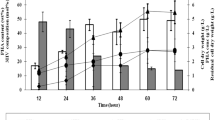Abstract
An important objective in the field of biopolymer research is to study the broad range of cultural conditions; by suitable choice of composition and processing conditions, polymer can often be tailor-made to have specific and desirable properties. Aulosira fertilissima CCC 444 when cultivated in a mixture of fructose and valerate produced poly(3-hydroxybutyrate-co-3-hydroxyvalerate) [P(3HB-co-3HV)] copolymer up to 537.5 mg L−1 containing 25 mol% 3HV monomers. Manipulation of the culture conditions such as varying pH, temperature, initial cell concentrations and dark incubation significantly affected the accumulation as well as composition of P(3HB-co-3HV) copolymer; therefore, the polymer finds a wider application. The molar fraction of 3HV tended to increase up to 35 mol% in the early phase of A. fertlissima cultivation, i.e. on the 7th day. An initial inoculum size of 80 mg dcw L−1 was found optimum for P(3HB-co-3HV) copolymer accumulation. Lower temperature conditions favoured the accumulation of copolymers containing higher molar fractions of 3HV monomers as compared to high temperature conditions. It was also observed that 3HV molar fractions in the copolymer can tailor up to 50 mol% by maintaining the pH of culture medium at 9.5, without significantly affecting the copolymer content (72 % dry cell weight). This opens up new possibilities of using A. fertilissima CCC 444 as a suitable feedstock for production of P(3HB-co-3HV) copolymer with varied 3HB and 3HV fractions for various industrial and pharmaceutical applications.




Similar content being viewed by others
References
Bhati R, Mallick N (2012) Production and characterization of poly(3-hydroxybutyrate-co-3-hydroxyvalerate) co-polymer by a N2-fixing cyanobacterium, Nostoc muscorum Agardh. J Chem Technol Biotechnol 87:505–512
Bluhm TL, Hamer GK, Marchessault RH (1986) Isodimorphism in bacterial poly(β-hydroxybutyrate-co-β-hydroxyvalerate). Macromolecules 19:2871–2876
Byrom D (1992) Production of poly-β-hydroxybutyrate and poly-β-hydroxyvalerate copolymers. FEMS Microbiol Rev 103:247–250
Chinwetkitvanich S, Randall CW, Panswad T (2004) Effects of phosphorus limitation and temperature on PHA production in activated sludge. Water Sci Technol 8:135–143
Choi J, Lee SY (1999) High-level production of poly(3-hydroxybutyrate-co-3-hydroxyvalerate) by fed-batch culture of recombinant Escherichia coli. Appl Environ Microbiol 65:4363–4368
Doi Y, Kitamura S, Abe H (1995) Microbial synthesis and characterization of poly(3-hydroxybutyrate-co-3-hydroxyhexanoate). Macromolecules 28:4822–4828
Doi Y, Tamaki A, Kunioka M, Soga K (1998) Production of copolyesters of 3-hydroxybutyrate and 3-hydroxyvalerate by Alcaligenes eutrophus from butyric and pentanoic acids. Appl Microbiol Biotechnol 28:330–334
Lama L, Nicolaus B, Calandrelli V, Maria MC, Romano I, Gambacorta A (1996) Effect of growth conditions on endo- and exopolymer biosynthesis in Anabaena cylindrica 10C. Phytochemistry 42:655–659
Lee S (1996) Bacterial polyhydroxyalkanoates. Biotechnol Bioeng 49:1–4
Lee WH, Azizan MNM, Sudesh K (2004) Effects of culture conditions on the composition of poly(3-hydroxybutyrate-co-4-hydroxybutyrate) synthesized by Comamonas acidovorans. Polym Degrad Stab 84:129–134
Lee WH, Loo CY, Nomura CT, Sudesh K (2008) Biosynthesis of polyhydroxyalkanoate copolymers from mixtures of plant oils and 3-hydroxyvalerate precursors. Bioresour Technol 99:6844–6851
Mallick N, Gupta S, Panda B, Sen R (2007) Process optimization for poly(3-hydroxybutyrate-co-3-hydroxyvalerate) co-polymer production by Nostoc muscorum. Biochem Eng J 37:125–130
Page W, Manchak J, Rudy B (1992) Formation of poly(3-hydroxybutyrate-co-3-hydroxyvalerate) by Azotobacter vinelandii UWD. Appl Environ Microbiol 58:2866–2873
Pouton CW, Akhtar S (1996) Biosynthetic polyhydroxyalkanoates and their potential in drug delivery. Adv Drug Deliv Rev 18:133–162
Rai LC, Mallick N, Singh JB, Kumar HD (1991) Physiological and biochemical characteristics of a copper tolerant and a wild type strain of Anabaena doliolum under copper stress. J Plant Physiol 138:68–74
Riis V, Mai W (1988) Gas chromatographic determination of poly-β-hydroxybutyric acid in microbial biomass after hydrochloric acid propanolysis. J Chromatogr 445:285–289
Rippka R, Deruelles J, Waterbury JB, Herdman M, Stanier RY (1979) Generic assignments, strain histories and properties of pure cultures of cyanobacteria. J Gen Microbiol 111:1–61
Roberts JR, Lu WP, Ragsdale SW (1992) Acetyl-coenzyme A synthesis from methyltetrahydrofolate, CO, and coenzyme A by enzymes purified from Clostridium thermoaceticum: attainment of in vivo rates and identification of rate-limiting steps. J Bacteriol 174:4667–4676
Samantaray S, Mallick N (2012) Production and characterization of poly-β-hydroxybutyrate (PHB) polymer from Aulosira fertilissima. J Appl Phycol 24:803–814
Samantaray S, Mallick N (2014) Production of poly(3-hydroxybutyrate-co-3-hydroxyvalerate) co-polymer by a diazotrophic cyanobacterium Aulosira fertilissima. J Appl Phycol 26:237–245
Sudesh K (2012) Polyhydroxyalkanoates from palm oil: biodegradable plastics. Springer, New York, 130 pp
Taidi B, Anderson AJ, Dawes EA, Byrom D (1994) Effect of carbon source and concentration on the molecular mass of poly(3-hydroxybutyrate) produced by Methylobacterium extroquens and Alcaligenes eutrophus. Appl Microbiol Biotechnol 46:451–463
Volova TG, Kalacheva GS (2005) The synthesis of hydroxybutyrate and hydroxyvalerate copolymers by the bacterium Ralstonia eutropha. Microbiology 74:54–59
Yellore V, Desia A (1998) Production of poly-β-hydroxybutyrate from lactose and whey by Methylobacterium sp. ZP24. Lett Appl Microbiol 26:391–394
Yu J, Si YT, Wong WKR (2002) Kinetics modeling of inhibition and utilization of mixed volatile fatty acids in the formation of polyhydroxyalkanoates by Ralstonia eutropha. Process Biochem 37:731–738
Zakaria MR, Ariffin H, Johar NAM, Abd-Aziz S, Nishida H, Shirai Y, Hassan MA (2011) Biosynthesis and characterization of poly(3-hydroxybutyrate-co-3-hydroxyvalerate) copolymer from wild-type Comamonas sp. EB172. Polym Degrad Stab 95:1382–1386
Acknowledgments
Financial support from the Department of Biotechnology, New Delhi, India, is thankfully acknowledged.
Author information
Authors and Affiliations
Corresponding author
Rights and permissions
About this article
Cite this article
Samantaray, S., Mallick, N. Role of cultural variables in tailoring poly(3-hydroxybutyrate-co-3-hydroxyvalerate) copolymer synthesis in the diazotrophic cyanobacterium Aulosira fertilissima CCC 444. J Appl Phycol 27, 197–203 (2015). https://doi.org/10.1007/s10811-014-0299-1
Received:
Revised:
Accepted:
Published:
Issue Date:
DOI: https://doi.org/10.1007/s10811-014-0299-1




